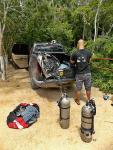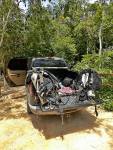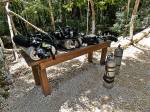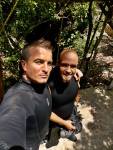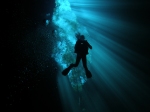Advantages of Sidemount Diving
Flexibility
Sidemount diving offers divers significant benefits of the flexibility of their approach. Unlike back-mounted doubles acquiring and transporting Sidemount suitable cylinders is often much more convenient and accessible. The Sidemount diving configuration allows the travelling diver to conduct recreational, technical and/or overhead environment dives without having to source traditional back-mounted cylinders. When diving in remote locations the transportation of diving logistics, especially by hand, is considerably less physically arduous.
Sidemount diving equipment is generally lighter and less bulky than back-mounted alternatives allowing for easier and cheaper travel.
Accessibility
Unlike back-mounted cylinders, the side mount diver has immediate access to, and observation of, the regulators and tank valves of their cylinders. This enables immediate problem identification and allows swifter resolution without recourse to ‘behind the head’ shutdown drills that require a higher level of mobility, flexibility and freedom to operate.
Streamlining
The Sidemount diving configuration places cylinders under the divers armpits in line with their body. This decreases water resistance, improving air consumption and reducing fatigue, whilst also allowing the diver to pass through smaller restrictions than would otherwise be impossible in back-mounted cylinders. The flexibility to remove tanks and propel them in front allows the diver to pass through very small passages and holes when penetration diving.
Safety
Increased accessibility to life-supporting regulators, first-stages and valves improves efficiency and speed of critical cylinder shutdown. This allows immediate gas-loss identification and provides the diver with quick access to alternative safety procedures such as regulator swapping between cylinders or valve-‘feathering’ to access gas within a cylinder whose regulator has malfunctioned or is free-flowing.
Stowage of the cylinders next to the diver’s torso and behind the arms serves to protect vulnerable valves and regulator first-stages from impact, abrasion damage or accidental shutdown through contact with a ceiling. It also significantly reduces the risk of entanglement behind the diver.
Comfort
Many divers will testify that Sidemount diving offers greater stability and easy-to-attain trim and control in the water. It is also less physically tiring to carry and don Sidemount equipment than with traditional back-mounted doubles particularly when operating from a small boat or a rough shore entry.
The ability to attach, remove and replace cylinders whilst in the water allows the diver to avoid ever having to carry heavy-weight back-mounted cylinders. This is combined with reduced physical exertion when conducting regulator shutdown procedures, a major benefit to technical divers who suffer from shoulder or back discomfort or reduced mobility from old injuries.
Redundancy of gas
Whilst technical divers have always utilized a redundant gas system, either isolated-manifold or independent back-mounted cylinders, recreational divers have traditionally resorted to using ‘pony cylinders’ or ‘ascent bottles’ as contingencies against out-of-air emergencies. Whether attached to the primary cylinder, or slung at the chest, these cylinders often presented problems with stability and streamlining whilst only providing a bare minimum supply of gas for an emergency ascent.
Sidemount diving with two cylinders helps resolve stability and streamlining issues and ensures that a truly capable redundant supply of gas is maintained.
Technical divers debate the pros and cons of independent cylinders versus isolated-manifold doubles. Back-mounted manifold cylinders provide easy access to complete gas supplies in the event of a regulator failure and shutdown. However the manifold itself creates additional O-ring failure points and a failure in that component will deprive the technical diver of at least one-half of their remaining gas supply. Independent cylinders, when in sidemount, provide true gas redundancy whilst offering access to all remaining gas.
[vimeo http://vimeo.com/57902801%5D



